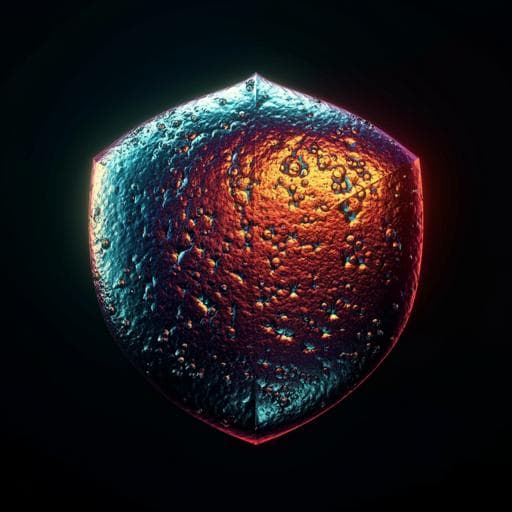
Chemistry
Molybdenum effects on the stability of passive films unraveled at the nanometer and atomic scales
V. Maurice and P. Marcus
This groundbreaking research by Vincent Maurice and Philippe Marcus explores how molybdenum at nano and atomic scales enhances the stability of passive films on various stainless steel surfaces. By delving into advanced surface analysis and DFT modeling, they reveal how molybdenum improves corrosion resistance and protects against chloride ion penetration, making it a vital component in the fight against corrosion.
~3 min • Beginner • English
Introduction
The paper addresses how molybdenum enhances the stability of passive films on stainless steels and related Cr-bearing alloys in chloride-containing environments. Passivity provides corrosion protection via a thin duplex oxide with a Cr(III)-rich inner barrier layer and an outer exchange layer, but aggressive anions like Cl− can trigger localized corrosion. While Cr is essential for forming a protective Cr(III) oxide, the precise role of Mo remains debated: it may prevent passive film breakdown by impeding chloride ingress and stabilizing the barrier, or it may mainly reduce active dissolution and promote self-repair after breakdown. The study compiles recent experimental and DFT results to clarify Mo’s multi-scale effects, emphasizing the influence of nanoscale compositional/structural defects generated during pre-passivation on later corrosion behavior and identifying where and how Mo acts within the duplex film to resist Cl−-induced breakdown.
Literature Review
Foundational work established that passive films on stainless steels are nanometer-scale duplex layers with a Cr(III)-oxide-rich inner barrier and a hydroxide/oxide outer layer; thicknesses are typically 1–3 nm and compositions depend on alloy and passivation conditions. Cr enriches in the inner layer and is responsible for low dissolution rates, while Mo (when present) further enriches during passivation in aqueous media. Prior studies propose non-equilibrium solute capture during rapid oxide formation and highlight substrate modification beneath the oxide (Ni enrichment). The role of Mo remains contested: evidence supports both mitigation of passivity breakdown (e.g., Mo oxides concentrate near the outer layer, hinder Cl− penetration, suppress dissolution, and may prevent voiding via Cr outward diffusion) and enhanced repassivation/self-repair (Mo reduces active dissolution rates, with behavior noted on Ni-based alloys involving Mo enrichment in the transpassive region and potential formation/dissolution of molybdates). Mo additions in austenitic steels significantly increase pitting resistance compared to Mo-free analogs and molybdate in solution is an established inhibitor. The literature also recognizes that nanoscale heterogeneities originate during initial oxidation; Cr-rich nuclei form at step edges and Fe-rich oxides can nucleate where local Cr supply is temporarily depleted, implying Fe-rich weak sites in the inner layer where breakdown may initiate.
Methodology
- Model surfaces and alloys: FeCrNi(Mo) and FeCrNi single-crystal surfaces, 316L stainless steel, and Cr- and Mo-bearing multi-principal element alloys (MPEAs: Cr25Fe25Co5Ni40Mo5 and Cr15Fe10Co5Ni60Mo10; an Mo-free Cr35Fe20Co5Ni40 comparator), all single-phase fcc.
- Surface preparation and controlled oxidation: Oxide-free single-crystal surfaces cleaned in UHV; stepwise exposure to ultra-low O2 pressure at room temperature or 250 °C to study native oxide nucleation/growth. Native oxide surfaces (post mechanical/vibratory polishing) also examined. Thermal pre-oxidation at low O2 pressure applied to FeCrNiMo and 316L.
- Transfer and electrochemical treatments: Closed system enabling direct transfer from UHV to Ar-filled chamber/glovebox for electrochemistry, minimizing air exposure. Passivation conducted in 0.05 M H2SO4(aq): at open circuit potential (OCP) to form passive films and under anodic polarization to study steady-state passive films. Potentiostatic protocols: for 316L, +0.3 V/SHE; for MPEAs, +0.64 V/SHE. Accelerated chloride challenge by stepwise NaCl addition up to 4.7 M without changing pH, after initial passivation in Cl-free electrolyte.
- Surface and depth analysis: In situ XPS and STM during initial oxidation in UHV to resolve nucleation/growth and composition at nanometer/atomic scales. Ex situ XPS (including angular-resolved XPS) to quantify bilayer composition and depth distribution of species; ToF-SIMS depth profiling to map Cl and Mo species (MoO2, MoO3) and mixed XMOOx secondary ions (X=Cr, Fe, Ni). Bilayer attenuation models used to quantify layer thicknesses and species distributions.
- Surface finish variable: Traditional mechanical polishing vs vibratory polishing on 316L to assess effects on initial native oxide composition and subsequent passivity.
- DFT modeling: DFT+U calculations on corundum (0001)-terminated Cr2O3 and Fe2O3 slabs. Mo substitution at surface/sub-surface metal sites, energy preferences, Bader and formal charge analysis on neutral and charged surfaces. Computation of formation energies for metal vacancies (Cr or Fe), oxygen vacancies, and coupled vacancies in Mo-substituted vs unsubstituted matrices to assess how Mo affects defect energetics relevant to chloride ingress and cation dissolution.
Key Findings
- Initial oxidation and defect formation: On FeCrNi(100), Cr(III)-rich nuclei form preferentially at step edges (via surface diffusion and vacancy-mediated pumping), while Fe-rich oxide nucleates adjacent to steps or at terrace defects where local Cr is depleted. This produces nanoscale compositional heterogeneity (Fe-rich weak sites) within the inner barrier layer of the native oxide.
- Passivation-induced alterations: In 316L SS exposed to 0.05 M H2SO4 at OCP, faster dissolution of Fe oxides thins native oxide but enriches Cr(III) and Mo(IV,VI), predominantly in the outer layer. Under anodic polarization, barrier-layer thickness increases (more Cr(III) oxide) and the outer layer remains Mo-enriched. Pre-oxidized surfaces (ULP O2) show thinner initial films but stronger Mo enrichment in the outer layer after OCP and anodic passivation, improving protection during OCP-to-passive transitions.
- Surface finish effects (316L): Vibratory polishing increases initial Cr and Mo enrichment in the native oxide, yielding a thicker Cr(III)-rich barrier and more Mo(IV,VI)-rich outer layer. Electrochemical testing shows lower currents at active/passive transition and in near steady-state passivity, fewer metastable pitting events, and higher chloride concentration required to trigger stable pitting/crevice corrosion compared to traditionally polished surfaces.
- MPEAs corrosion behavior: In Cl-free H2SO4 at +0.64 V/SHE, higher Cr content lowers passive currents. In chloride-containing electrolytes up to 4.7 M NaCl, Mo-free MPEA exhibits metastable pitting followed by localized corrosion initiation; Mo-bearing MPEAs (Cr25Fe25Co5Ni40Mo5 and Cr15Fe10Co5Ni60Mo10) show no passivity breakdown or localized corrosion, with passive currents continuing to decrease.
- Chloride penetration depth (ToF-SIMS): Cl interacts with the surface but penetration is largely confined to the outer layer. The inner barrier layer shows no Cl penetration (Cr15Fe10Co5Ni60Mo10) or only trace penetration (Cr25Fe25Co5Ni40Mo5) in the most severe case without pre-passivation; penetration never reaches the metal substrate. Increasing Mo content/enrichment in the outer layer (≈30 at.% for 10 at.% Mo alloy vs ≈17 at.% for 5 at.% Mo alloy by XPS) reduces penetrated chloride. Pre-passivation in Cl-free electrolyte further limits Cl access, attributed to reduced nanostructural defects.
- Localization and speciation of Mo: ToF-SIMS shows Mo(VI) (MoO3 secondaries) concentrated in the outer exchange layer; Mo(IV) (MoO2 secondaries) is distributed deeper and dominates in/near the inner barrier. A MoO2 peak near the outer/inner interface suggests an interfacial (discontinuous) Mo(IV)-rich layer with an equivalent thickness up to ≈0.12 nm (fractional monolayer). XPS reveals an intermediate Mo species (binding energies between Mo(IV) and Mo(VI)), located beneath Mo(IV), consistent with Mo(IV+δ) within the Cr(III)-rich inner layer, including Fe-rich defect sites. ToF-SIMS also detects minor mixed XMOOx (X=Cr, Fe, Ni) species near the substrate interface, indicating mixing in the inner region.
- DFT insights: Mo substitution in corundum (0001) surfaces is exothermic, most stable in the third metal plane; more favorable in Fe2O3 than Cr2O3, implying preferential stabilization of Fe-rich zones. On neutral surfaces Mo is near +3; added positive charge localizes first on Mo, making it +4, and in Fe2O3 can reach an intermediate between +4 and +6 under further charging. Mo substitution lowers the formation energy of metal vacancies (especially Fe vacancies) but raises the energy for O vacancies, more strongly in Fe2O3 than Cr2O3. Upon metal vacancy formation, charge localizes on Mo (reaching +4 to between +4 and +6 in Fe2O3). These results support: (i) Mo-assisted selective dissolution of Fe and its replacement by Cr and Mo in Fe-rich weak sites; (ii) suppression of O-vacancy formation, impeding Cl− entry pathways within the inner layer.
- Mechanistic synthesis: Mo(VI) in the outer layer acts as a barrier to Cl− ingress; Mo(IV) near the inner interface protects structural/compositional defect sites; Mo(IV+δ) within Fe-rich defect zones promotes Fe removal and Cr/Mo incorporation while reducing O-vacancy formation. Together, these effects cure Fe-rich weak sites and enhance resistance to Cl−-induced passivity breakdown, even under high-chloride conditions.
Discussion
The findings resolve the debated role of Mo by showing concurrent preventive and healing effects that stabilize passivity. Preventive: Mo(VI) enrichment in the outer layer reduces deep chloride penetration, keeping most Cl− from reaching the inner Cr(III)-rich barrier. Healing/stabilization: In regions where Cl− accesses deeper layers, Mo(IV) concentrated near the outer/inner interface and Mo(IV+δ) within Fe-rich compositional defects mitigate breakdown by two routes demonstrated by DFT and experiments: (1) accelerating selective Fe dissolution and substitution by Cr and Mo, transforming Fe-rich weak spots into more protective Mo/Cr-containing oxide; (2) disfavoring O-vacancy formation in both Cr2O3 and Fe2O3 matrices, thereby blocking a key pathway for chloride incorporation and transport. Surface treatments (vibratory polishing) and controlled pre-oxidation enhance initial Cr and Mo enrichment, reducing defect density and improving resilience to chloride. On Mo-bearing MPEAs, the synergy of high Cr with Mo enrichment prevents passivity breakdown even at up to 4.7 M NaCl, evidencing the robustness of the proposed mechanisms. Overall, the multi-scale localization of Mo—outer-layer Mo(VI), interfacial Mo(IV), and inner-layer Mo(IV+δ) in defect zones—directly addresses the corrosion challenge by both impeding chloride ingress and curing nanoscale weak sites that would otherwise nucleate localized corrosion.
Conclusion
This work integrates advanced surface analysis (STM, XPS, ToF-SIMS) and DFT modeling to clarify how Mo enhances the stability of chromium-oxide-based passive films on stainless steels and Mo-bearing MPEAs. Key contributions include: (1) establishing the nanoscale origin of Fe-rich weak sites during early oxidation; (2) demonstrating Mo(VI) enrichment in the outer layer that blocks deep Cl− penetration; (3) identifying Mo(IV) near the outer/inner interface and Mo(IV+δ) within Fe-rich zones of the inner Cr(III) barrier that promote Fe selective dissolution and replacement by Cr/Mo while suppressing O-vacancy formation; (4) showing that surface finish and controlled pre-oxidation enhance Cr/Mo enrichment and improve resistance to Cl−-induced breakdown; and (5) evidencing, on Mo-bearing MPEAs, the absence of passivity breakdown even at very high chloride concentrations. Future work should include real-time, in situ studies of Mo-bearing alloy oxidation in the presence of water vapor to resolve nucleation/growth pathways; atomic-scale mapping of Mo at intergranular boundaries and defect sites within the inner layer; resolving the precise nature of the intermediate Mo species; and correlating defect density reduction strategies with long-term performance across varied pH and potential regimes.
Limitations
- Direct, real-time observation of nanoscale Fe-rich defect sites during passivation and their evolution under chloride is extremely challenging; some inferences rely on indirect evidence and models.
- Effects of water vapor on nucleation and growth for Mo-bearing stainless steels were not directly studied; extrapolations from UHV conditions may not fully capture aqueous environments.
- ToF-SIMS depth profiling cannot unambiguously determine oxidation states; interpretation of Mo(IV), Mo(VI), and intermediate species relies on combined XPS and secondary ion assignments and may be influenced by fragmentation.
- Quantification employs bilayer attenuation models and assumes specific species distributions (e.g., 100% Cr(III) in the inner layer), which may oversimplify local heterogeneity.
- Results focus on selected model alloys, specific electrolytes (0.05 M H2SO4 with stepwise NaCl), and fixed potentials/durations; generalizability to other environments and microstructures requires further validation.
Related Publications
Explore these studies to deepen your understanding of the subject.







